April 2016 LIP of the Month
Geochemistry of the Ediacaran (c. 570 Ma) Volyn flood basalt province, south-western East-European platform
Leonid Shumlyanskyy
M.P. Semenenko Institute of geochemistry, mineralogy and ore formation, Kyiv, Ukraine
Palladina ave. 34, 03680, Kyiv, Ukraine
Introduction
The Volyn continental flood basalt (VP) province represents a relatively well-preserved example of the Neoproterozoic continental large igneous province. It developed during the break-up of the Rodinia supercontinent and is coeval or nearly coeval with numerous other manifestations of basaltic volcanism in Baltica (Bingen et al., 1998; Andréasson, 1994, and references therein) and Laurentia (Puffer, 2002, and references therein). The importance of the VP for understanding of the processes of break-up of the Rodinia supercontinent was discussed in our previous publication (Shumlyanskyy et al., 2007). However, direct geochemical comparison of the Volyn continental flood basalts with other LIP events related to the Rodinia break-up has been hampered by the absence of systematic geochemical information regarding the VP. Results of geochemical studies of rocks of the VP were reported by many authors (Bakun-Czubarow et al., 2002; Bialowolska et al., 2002; Nosova et al., 2005; 2008). However, none of these works dealt with all varieties of rocks present in the province. So, our efforts were focused on obtaining of the geochemical data-set that will embrace the whole range of volcanic rocks present in the Volyn continental flood basalt province. The obtained results allowed us to trace the evolution of volcanism in the VP, and to reach some conclusions about origin of initial melts. These results are presented in this communication. Our further efforts will be concentrated on geochemical comparison of the VP with other manifestations of the Ediacaran mafic volcanism in Baltica and Laurentia in order to establish the general features of evolution of magmatism during Rodinia break-up.
Tectonic setting and stratigraphy
The Volyn continental flood basalt province is located in western Ukraine, eastern Poland, and south-western Belarus. The core part of this area (80 000 km2) is occupied by basaltic flows, whereas volcanoclastic sediments (tuffs) expands the area of the province to 200,000 km2 (Kuzmenkova, 2009). The province can be traced over a distance of 770 km from Bialystok in Poland to Chernivtsy in Ukraine. Its width exceeds 300 km in the central part while the maximum thickness (up to 400–600 m) is confined to the axial part of the Volyn-Orsha aulacogen. The VP is located on the western margin of the East European platform, where it straddles the boundary between two main segments of Baltica, namely Sarmatia and Fennoscandia (Fig. 1).
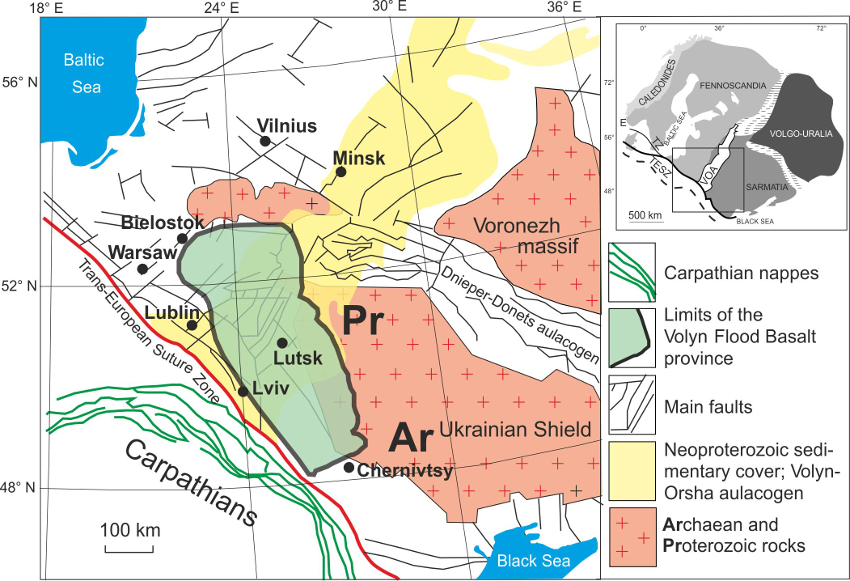
Figure 1. Schematic map of distribution of the Volyn flood basalts, simplified after Shumlyanskyy et al. (2016). Ar – Archaean Dniester-Bug domain of the Ukrainian shield; Pr – Palaeoproterozoic domain. Inset map: VOA indicates Volyn-Orsha aulacogen; E stands for Egersund dyke swarm and TZ – for Tornquist zone. The boundary between Sarmatia and Fennoscandia is buried under the Volyn-Orsha aulacogen.
Rocks that compose the VP rest upon the Neoproterozoic Polissya Series and Brody suite, and in places, directly overlay the crystalline basement (Figs. 1 and 2). The volcanic and volcanocalstic rocks of the Volyn continental flood basalt province constitute the Volyn Series and can be subdivided into a lowermost part (40–50 m), termed the Gorbashy suite, which is composed mainly of conglomerates and sandstones, while the main part of the Volyn Series consists of basic effusive and pyroclastic rocks (Fig. 2). Thin picrite flows present among clastic sediments of the Gorbashy suite. The volcanogenic sequence of the Volyn Series is subdivided into three parts in Ukraine (from bottom to top) called the Zabolottya, Babyne and Ratne suites (Birulyov, 1968). These rocks are poorly exposed and mainly available from numerous drill holes, while tuffs and basalts of the uppermost Ratne suite crop out in several quarries (Fig. 3) and were extensively investigated. Effusive rocks of the lowermost Zabolottya suite are less abundant and found almost entirely within the Volyn-Orsha aulacogen. They consist of one to eight basaltic flows with a subordinate (<25% of the total suite thickness) amount of pyroclastic material. The maximal thickness of the suite reaches 166 m. The Babyne suite is the most widely distributed and composed mainly of volcanoclastic sediments. The suite comprises layered, mainly fine- to medium-grained vitroclastic basaltic tuffs with abundant interlayers of fine-grained vitro-crystalloclastic and coarse lithoclastic tuffs. One to two basaltic flows occur in the central part of the Babyne suite, the thickness of which reaches 180 m. The Ratne suite is the uppermost one and is the best studied (Bialowolska et al. 2002; Nosova et al. 2008; Shumlyanskyy 2008). Tuffs are rare while basaltic flows vary in thickness from 5–10 to 50–60 m. There are up to ten basaltic flows and the total thickness of the suite can exceed 220 m. Intermediate and felsic (andesite-dacite) rocks appear locally in the north-western part of the Volyn province known as the Brest depression in Belarus (Makhnatch 1968). The maximum thickness of the felsic rocks is 112 m, but due to a small areal occurrence, they only constitute a few per cent of the total volume of the Volyn province.

Figure 2. Simplified stratigraphic column of the Late Proterozoic–Early Palaeozoic formations of the western Ukraine. Not to scale.

Figure 3. Quarry in Basaltove village (also known as Yanova Dolyna) 50.922846 N, 26.237037 E
Age of the Volyn continental flood basalt province
The stratigraphic age of the Volyn flood basalt sequence has been defined as Early Vendian (Kruglov and Tsypko, 1988). Shumlyanskyy et al. (2016) presented the review of the radiometric ages and results of the new U-Pb zircon and baddeleyite dates of rocks of the VP. According to these results, magmatic zircons from the high-Ti basalt crystallized at 573 ± 14 Ma, whereas the rhyolitic dacite yielded an age of 571 ± 13 Ma. Baddeleyite from the olivine dolerite sample gave a 206Pb/238U age of 626 ± 17 Ma, whereas the 207Pb/206Pb weighted average age of 567 ± 61 Ma is close to the zircon ages. Hence, age of the Volynian continental flood basalt province can be currently defined as c. 570 Ma, that correspond to the middle to late part of the Ediacaran period.
Geochemistry of the main rock varieties
A comprehensive geochemical investigation of the all rock varieties present in the Volyn continental flood basalt province allowed recognition of the six main types of mafic rocks. These rock types, from top to bottom, are: (1) high-Ti tholeiite basalts of the upper part of the Ratne Suite; (2) low-Ti, low-Nb tholeiite basalts of the lower part of the Ratne suite; (3) low-Ti Al-rich basalts of the Babyne suite; (4) olivine basalts of the Zabolottya suite; (5) picrites that locally occur among clastic sediments of the Gorbashy Suite; (6) sheet-like intrusive bodies of dolerites and gabbroic dolerites among clastic sediments of the Polissya Series.
According to Shumlyanskyy et al. (2016), chemical compositions of minerals and rocks vary regularly in the vertical section of the Volyn Series. Calcic plagioclase (up to An86), magnesian orthopyroxene (En82Fs13Wo5) and clinopyroxene (En59Fs9Wo32) are characteristics for picrites. These rocks contain completely altered olivine phenocrysts while the opaques are represented by chromite. Upwards in the section, plagioclase becomes more sodic and pyroxene more ferrous. Olivine is still present in the Babyne suite basalts but disappears in basalts of the Ratne suite. Plagioclase phenocrysts found in the Ratne suite basalts are very close in composition to plagioclases present in groundmass of picrites or Zabolottya suite basalts. Intrusive dolerites correspond in mineral chemistry to the Ratne suite basalts but contain olivine instead of orthopyroxene.
The whole-rock #Mg, ranging between 69 and 73 in picrite, gradually decreases upwards and reaches 35–60 in high-Ti basalts of the Ratne suite and intrusive dolerites. REE abundances and degree of their fractionation gradually increase upwards in the section (Fig. 4). A negative Eu anomaly is characteristic for picrites and for some of the Babyne suite basalts, while a weak positive Eu anomaly is found in low-Ti basalts of the Ratne suite and in dolerites.
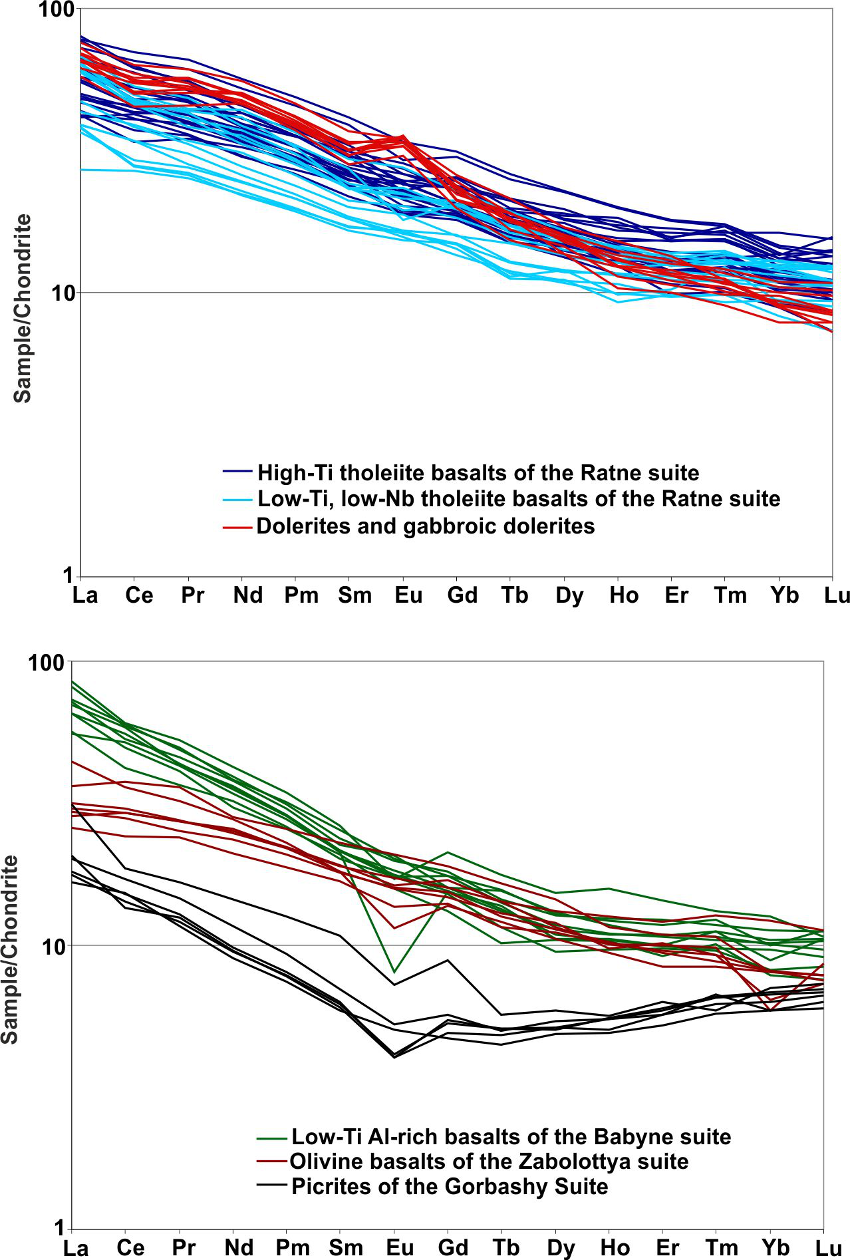
Figure 4. Chondrite-normalized patterns of REEs in rocks of the Volyn continental flood basalt province
The primordial mantle-normalized patterns of trace elements in rocks of the VP are shown in Fig. 5. There is a general tendency for the incompatible trace element abundance to increase upwards in the section of the Volyn continental flood basalt province, whereas content of compatible elements sharply decreases (Fig. 6). The gradual increase in the concentration of incompatible elements is disrupted by the Babyne Suite basalts, which have the highest content of incompatible trace elements.
The most incompatible elements (Rb, Th, U, K) demonstrate a wide range of variation that is explained by mobility of these elements in the processes of secondary alteration. In general, there is a gradual decrease of the primordial mantle-normalized concentrations from the most incompatible elements towards the moderately incompatible. All rock types demonstrate negative spikes of Sr and P of variable intensity, and positive Ba spike. A Nb-Ta anomaly is absent in the most trace-element-enriched rock types, but is very distinctive (negative anomaly) in the trace-element-poor rocks that compose lower parts of the Volyn Series.
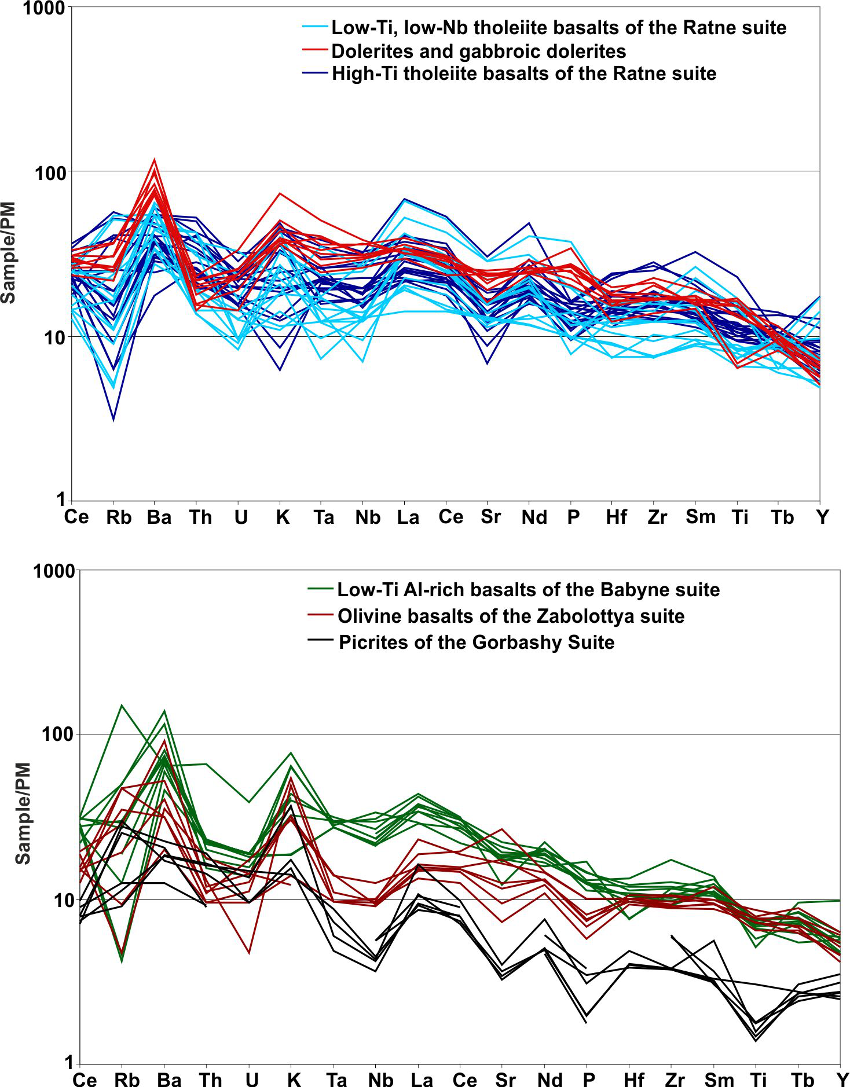
Figure 5. Primordial mantle-normalized patterns of incompatible trace elements in rocks of the Volyn continental flood basalt province
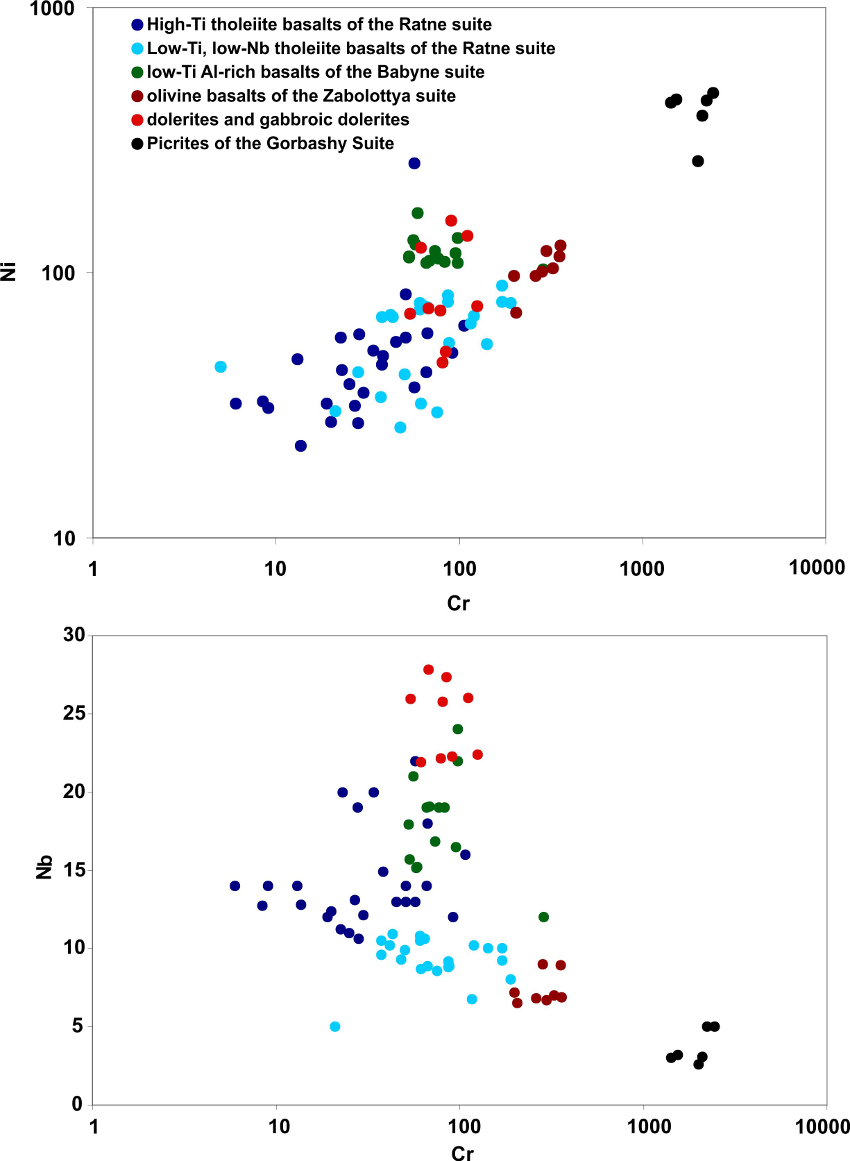
Figure 6. Variations of the compatible elements in rocks of the Volyn continental flood basalt province
Sr and Nd isotope compositions
All of the measured samples of rocks of the VP have negative values of εNd and positive values of εSr, calculated at 550 Ma (Fig. 7), and hence, demonstrate crustal isotope characteristics rather than mantle composition. The most prominent “crustal” composition is characteristic for picrites whereas upwards in the section the isotope composition of the rocks gradually shifts towards values more characteristic for the mantle-derived rocks. For instance, εNd in rocks gradually increases upwards from –12 in picrites to between –1 and –6 in high-Ti Ratne basalts and reaches values of –1 to –3 in dolerites. There is a pronounced link between chemical and isotope composition for the rocks in the Volyn continental flood basalt province. For instance, Nd isotope composition reveals a strong positive correlation with TiO2 concentration (Fig. 7).
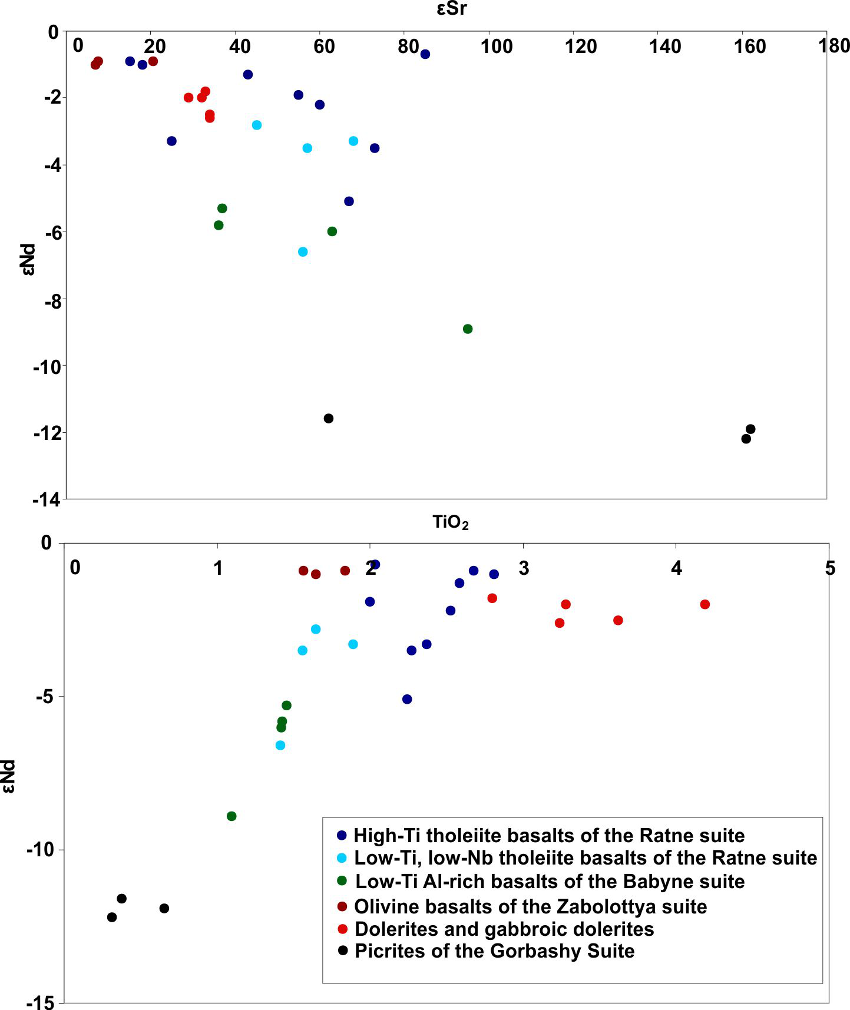
Figure 7. Sr and Nd isotope composition of rocks of the Volyn continental flood basalt province and variation of εNd with TiO2 concentration in rocks.
Origin of rocks of the Volyn continental flood basalt province
The regular variations of the mineral and rock chemistry in a section of the VP suggest that a simple crystal fractionation model may relate all rocks of the province to each other. As was assumed by Cox (1980), the initial melts for continental basalts must have a picritic composition in order to be in equilibrium with the mantle restite. Such rocks are present in the very bottom part of the VP, and could represent initial melt for the whole volcanic succession, whereas basaltic rocks and dolerites occur as successive differentiates of the primary picritic rocks. The composition of plagioclase, augite and Ti-magnetite phenocrysts found in basalts of the Ratne Suite supports this assumption. These phenocrysts differ sharply in composition from their counterparts present in the groundmass, indicating that phenocrysts had crystallized from a melt of different composition than the melt from which groundmass crystallized. At the same time, the composition of phenocrysts in the Ratne Suite basalts closely matches the composition of the minerals that compose groundmass of picrites and olivine basalts of the Zabolottya Suite. Apparently, phenocrysts started to crystallize from the more primitive melts of picritic composition whereas the groundmass crystallized from the evolved low-Mg# melt that had experienced fractionation.
However, geochemical and isotope data clearly indicate that rocks mentioned above having different geochemical types cannot be derived from a single melt. For instance, the most chemically primitive rocks (picrites) have the most evolved Sr and Nd isotope composition. Chemical fractionation of these mantle-derived initial melts cannot produce rocks with the more primitive isotope composition. This statement is clearly supported by the difference in isotope composition of the picrites (isotopically most evolved rocks of the VP) and olivine basalts of the Zabolottya Suite that immediately overlay the picrites and which have the most primitive Sr and Nd isotope compositions (Fig. 7). Hence, these rocks have crystallized from different batches of the mantle melts that possibly originated from different sources. The chemical composition of the Babyne Suite basalts represent additional evidence of the variability of mantle sources for Volynian continental flood basalts. The Babyne Suite basalts are rich in compatible Ni and incompatible Nb, LREE, K, Ba, and relatively poor in Cr (Fig. 4-6). These peculiarities of chemical composition make Babyne basalts different from all other rocks of the VP and cannot occur due to fractional crystallization. Apparently, the Babyne basalt originate from a specific batch of the mantle-derived melt.
The role of the crustal contamination can be estimated from the plot Th/Ta vs. εSr (Fig. 8). The upper-crustal rocks have high Th/Ta and high εSr values, in contrast to the mantle-derived rocks that have low Th/Ta and εSr. As can be seen from Fig. 8, olivine basalts of the Zabolottya Suite are the least contaminated rocks of the Volyn continental flood basalt province. High-Ti basalts of the Ratne Suite and intrusive dolerites are also moderately contaminated rocks, while picrites can be regarded as heavily contaminated rocks. The same conclusion can be reached from examination of the La/Nd vs. εNd plot (Fig. 8). In general, it may be concluded that the degree of crustal contamination gradually decreases upwards in the vertical section of the VP, with the exception of olivine basalts of the Zabolottya Suite which occur in the lower part of the volcanic succession and appear to be the least contaminated rock type.

Figure 8. Th/Ta vs. εSr and La/Nd vs. εNd plots that demonstrate variations in the degree of crustal contamination of rocks of the Volyn continental flood basalt province
A similar situation has been described in the Emeishan continental flood province, SW China, where the high-Ti basalts (enriched in incompatible trace elements and less contaminated) overlay low-Ti basalts (Xu et al., 2001). A gradual decrease in the degree of contamination is explained by the depletion of the walls of the feeding channels with respect to the fusible incompatible trace elements as these channels are been washed out by subsequent portions of the mantle melts. The same model may be applied to the VP, as there is a tendency for the later melts to be less contaminated. However, the case of the least contaminated Zabolottya olivine basalts indicates, that this model is oversimplified, and different portions of the melt used different feeding systems and were generated from different sites in the mantle.
A possible source of the initial melts may be assumed from the Zr/Nb vs. Ba/Nb and Dy/Yb vs. La/Yb plots (Fig. 9). The rational behind these plots is discussed by Riley et al., 2005 and Shumlyanskyy et al. (2016). As can be seen from these plots, initial melts for the earliest rocks of the VP were generated at relatively shallow depth and high degree of melting. With time, the melting site migrated to greater depth, whereas the degree of melting gradually decreased. Furthermore, rocks of the VP plot between fields of enriched mantle and lower continental crust, indicating the mixed source for the initial melts.
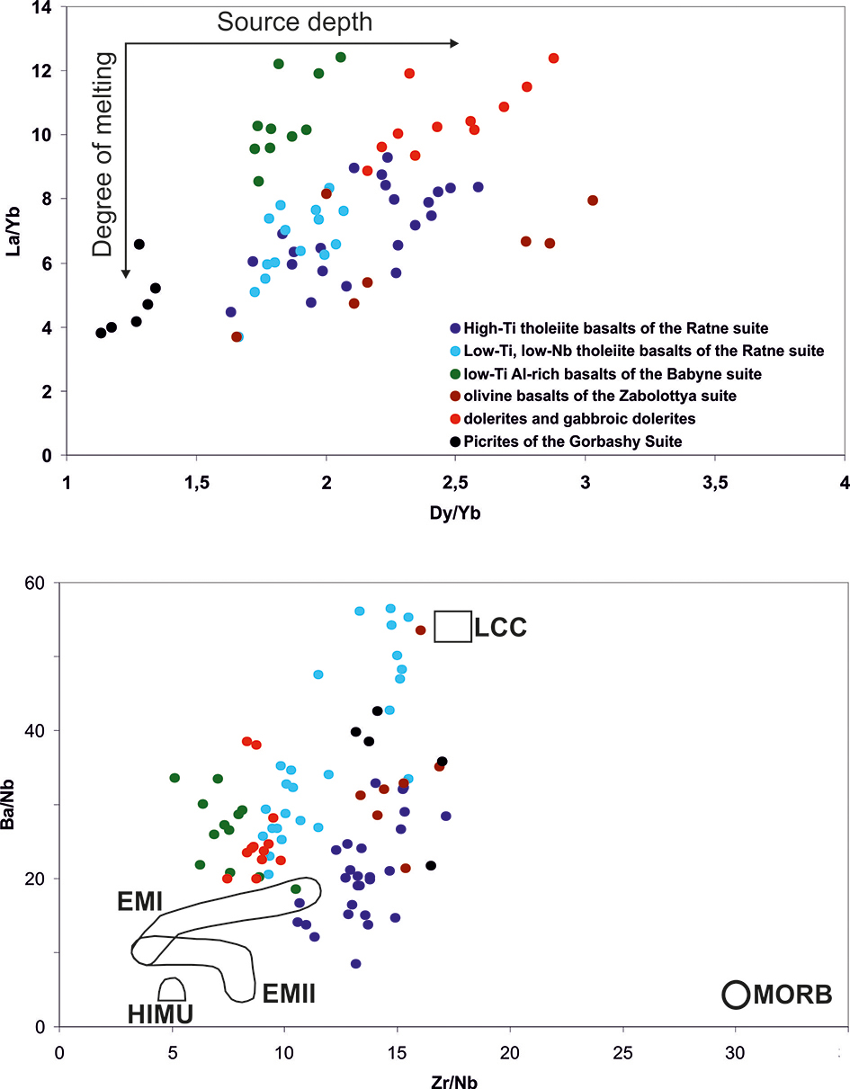
Figure 9. Dy/Yb vs. La/Yb and Zr/Nb vs. Ba/Nb plots for rocks of the Volyn continental flood basalt province. Abbreviations for reservoirs: LCC – Lower Continental Crust; MORB – Mid-Ocean
Ridge Basalts; EMI – Enriched Mantle type 1; EMII – Enriched Mantle type 2; HIMU – reservoirs with highly radiogenic Pb isotope ratios (high μ). The Zr/Nb and Ba/Nb values are according to Weaver (1991) (MORB, EM and HIMU) and Rudnick and Gao (2003) (LCC).
As noted above, most of the rocks of the Volyn continental flood basalt province have negative anomalies of Sr, P, and Ti, and some of them – Nb negative anomaly. Similar anomalies were found in Mesozoic Gondwana low-Ti flood basalts (Hergt et al., 1991). According to these authors, such anomalies are characteristic for rocks that originated from the subcontinental lithospheric mantle. This conclusion is in line with other evidences that include high degree of contamination, “evolved” Sr and Nd isotope compositions etc.
Crustal contamination may have the same effect on the melt’s chemistry as their origin from metasomatized lithospheric mantle (e.g. Pearce, 2008; Hollings et al., 2012; Ernst, 2014 and references therein). These two processes can be distinguished taking into account the intermediate bulk composition of the continental crust. Hence, crustal contamination must result in increase of SiO2 abundance and decrease of MgO, whereas melting of the metasomatized lithospheric mantle will have only minor effect on major elements composition. Indeed, there is no apparent correlation between SiO2 (and MgO) concentrations and Nd isotope composition, which is an argument in favour of interaction with mantle rather than of crustal contamination. However, there are some facts that support crustal contamination: (1) picrites of the VP are unusually rich in SiO2 (45.2 – 50.2 %) that may be explained by contamination by the siliceous crustal material; (2) basalts of the Ratne Suite contain numerous zircon xenocrysts that vary in age from c. 1220 Ma to Archaean (Shumlyanskyy et al., 2016), that also indicate extensive crustal contamination. In general, there is a reverse correlation between the abundance of incompatible trace elements and the degree of crustal contamination: rocks with low concentrations of incompatible trace elements have lower εNd, higher εSr, and deeper negative Nb-Ta, Sr, P, and Ti anomalies. These peculiarities of their composition can be explained by crustal contamination, as the smaller amount of the incompatible trace elements is present in the melt, the easier it will be modified by the crustal contaminants.
Click to open/close ReferencesReferences
Andréasson, P.-G., 1994. The Baltoscandian margin in Neoproterozoic – early Palaeozoic times. Some constraints on terrane derivation and accretion in the Arctic Scandinavian Caledonides. Tectonophysics, 231, 1-32.
Bakun-Czubarow, N., Bialowolska, A., Fedoryshyn, Yu., 2002. Neoproterozoic flood basalts of Zabolottya and Babino beds of the volcanogenic Volhynian series and Polesie series dolerites in the western margin of the East European craton. Acta Geologica Polonica, 52 (4), 481-496.
Bialowolska, A., Bakun-Czubarow, N., Fedoryshyn, Yu., 2002. Neoproterozoic flood basalts of the upper beds of the Volhynian series (East European craton). Geological Quaternary, 46 (1), 37-57.
Bingen, B., Demaiffe, D., van Breemen, O., 1998. The 616 Ma old Egersund Basaltic Dike swarm, SW Norway and Late Neoproterozoic opening of the Iapetus Ocean. The Journal of Geology, 106, 565-574.
Birulyov, A.E., 1968. On the stratigraphy of the Volyn Series (Upper Precambrian) of the Volyn region. Sovetskaya geologiya 3, 23–33. (In Russian).
Cox, K.G., 1980. A model for flood basalt vulcanism. Journal of Petrology, 21, 629-650.
Ernst, R.E., 2014. Large Igneous Provinces. Cambridge University Press, 653 p.
Hergt J.M., Peate D.W., Hawkesworth C.J., 1991. The petrogenesis of Mesozoic Gondwana low-Ti flood basalts. Earth and Planetary Science Letters, 105, 134-148.
Hollings P., Smyk M., Cousens B., 2012. The radiogenic isotope characteristics of dikes and sills associated with the Mesoproterozoic Midcontinent Rift near Thunder Bay, Ontario, Canada. Precambrian Research, 214-215, 269-279.
Kruglov, S.S., Tsypko, A.K (Eds.), 1988. Tectonics of Ukraine. Nedra, Moscow, 254 pp. (In Russian).
Kuzmenkova, O.F., 2009. Geochemistry of the continental flood basalt province of the Vendian of Belarus. Unpubl. Ph.D. thesis, Minsk, 285 p.
Makhnatch, A.S., 1968. Intermediate effusive Vendian rocks of the Brest depression. Doklady Akademii Nauk BSSR, 12(2), 148–151. (In Russian).
Nosova, A.A., Kuzmenkova, O.F., Veretennikov, N.V., Petrova, L.G., Levskiy, L.K., 2008. Neoproterozoic Volyn-Brest igneous province in the west of the East-European craton: peculiarities of the intraplate magmatism in the area of ancient shear zone. Petrology, 16, 115–147, (In Russian).
Novova, A.A., Veretennikov, N.V., Levskiy, L.K., 2005. Nature of the mantle source and peculiarities of the crustal contamination of the Neoproterozoic flood basalts of the Volyn province (Nd- and Sr- isotope data and ICP-MS geochemistry). Doklady Akademii Nauk, 400 (4), 1-5. (In Russian).
Pearce, J.A., 2008. Geochemical fingerprinting of oceanic basalts with applications to ophiolite classification and the search for Archean oceanic crust. Lithos 100, 14–48.
Puffer, J.H., 2002. A Late Neoproterozoic eastern Laurentian superplume: location, size, chemical composition, and environmental impact. American journal of science, 302, 1-27.
Riley, T.R., Leat, P.T., Curtis, M.L., Millar, I.L., Duncan, R.A., Fazel, A., 2005. Early-middle Jurassic dolerite dykes from Western Dronning Maud Land (Antarctica): identifying mantle sources in the Karoo large igneous province. Journal of Petrology, 46, 1489–1524.
Rudnick, R.L., Gao, S., 2003. The Composition of the Continental Crust. In: The Crust (ed. R.L. Rudnick), p. 1-64. Treatise on Geochemistry (eds. H.D. Holland and K.K. Turekian), v. 3, Elsevier-Pergamon, Oxford.
Shumlyanskyy, L, Mitrokhin, O., Billström, K., Ernst, R., Vishnevska, E., Tsymbal, S., Cuney, M., Soesoo, A., 2016. The ca. 1.8 Ga mantle plume related magmatism of the central part of the Ukrainian shield. GFF, 138, 86-101.
Shumlyanskyy, L., Nosova, A., Billström, K., Söderlund, U., Andréasson, P.-G., Kuzmenkova, O., 2016. The U-Pb zircon and baddeleyite ages of the Neoproterozoic Volyn Large Igneous Province: implication for the age of the magmatism and the nature of a crustal contaminant. GFF, 138, 17-30.
Shumlyanskyy, L.V., 2008. Geochemistry and origin of basalts of the Ratne Suite of the Vendian Volynian continental flood province. Mineralogical journal (Ukraine), 30 (1), 48–65. (In Ukrainian).
Shumlyanskyy, L.V., 2012. Evolution of the Vendian continental flood basalt magmatism of the Volyn area. Mineralogical journal (Ukraine), 34 (4), 50-68. (In Ukrainian).
Shumlyanskyy, L.V., Andréasson, P.-G., Buchan, K.L., Ernst, R.E., 2007. The Volynian Flood Basalt Province and coeval (Ediacaran) magmatism in Baltoscandia and Laurentia. Mineralogical journal (Ukraine), 29 (4), 47-55.
Weaver, B.L., 1991. The origin of ocean island basalt end-member compositions: trace element and isotopic constraints. Earth and Planetary Science Letters, 104, 381–397.
Xu, Y., Chung, S.-L., Jahn, B., Wu, G., 2001. Petrologic and geochemical constraints on the petrogenesis of Permian–Triassic Emeishan flood basalts in southwestern China. Lithos, 58, 145–168.